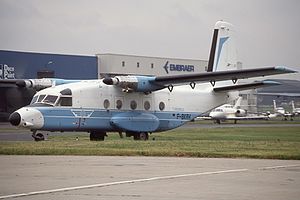|
Nord 260
The Nord 260, built in prototype form as the Max Holste MH.260 Super Broussard, ("Super Bushranger"), was a turboprop-powered, uprated version of the piston-engined Max Holste MH.250 Super Broussard, that was further developed into the Aérospatiale N 262. Design and developmentIn 1957, Avions Max Holste began work on a twin-engined follow on to its successful Broussard single-engined utility aircraft.[1][2] The new aircraft, the Max Holste MH.250 Super Broussard, was a high-wing cantilever monoplane powered by two 600 hp (450 kW) Pratt & Whitney R-1340 radial engines and could accommodate 17–22 passengers.[2] The sole MH-250 made its first flight on 20 May 1959.[3][2] Max-Holste developed the MH.250 into the turboprop-powered MH.260, to meet a perceived market for a replacement for the DC-3 and for feeder-liner services.[1][2] Like the MH.250, the MH.260 was a high-wing aircraft with a square-section fuselage, which was of all-aluminum construction. The aircraft had a retractable tricycle undercarriage, with the main wheels retracting into fuselage-mounted fairings. Control surfaces were fabric covered. The MH.260 was 1.4 m (4 ft 7 in) longer than the MH.250, allowing 20–23 passengers to be carried, or up to 3,885 kg (8,565 lb) of cargo in place of passengers. The aircraft was powered by two Turbomeca Bastan engines.[4][5] The prototype MH.260, powered by two 730 shp (540 kW) Bastan IIIs, first flew on 29 July 1960.[2][6][a] The prototype was re-engined with 986 shp (735 kW) Bastan IVs in October 1960.[2][6] The construction of a batch of 10 MH.260s was started with a French government subsidy, and a collaboration arrangement agreed with Nord Aviation, but financial problems at Max Holste led to the programme being taken over by completely by Nord, with production aircraft known as Nord 260s.[1] Only nine production Nord 260s were completed, with the tenth aircraft remaining unflown and used as a source of spare parts. Production was switched to the more advanced Nord 262 development.[7] Operational historyThree Nord 260s were briefly operated under a lease agreement by the Norwegian airline Widerøe before being returned to Nord, while the French domestic airline Air Inter also evaluated the Nord 260. No commercial orders followed, however, although Air Inter later ordered the Nord 262. Five Nord 260s were delivered to the Centre d'essais en vol (CEV), the French flight test establishment, being used for experiments or as transports supporting the CEV's operations.[7][8] Variants
OperatorsSpecifications (Nord 260)Data from MH-260 Super Broussard[9] General characteristics
Performance
References
Bibliography
Further reading
External linksWikimedia Commons has media related to Nord 260. |
||||||||||||||||||||
